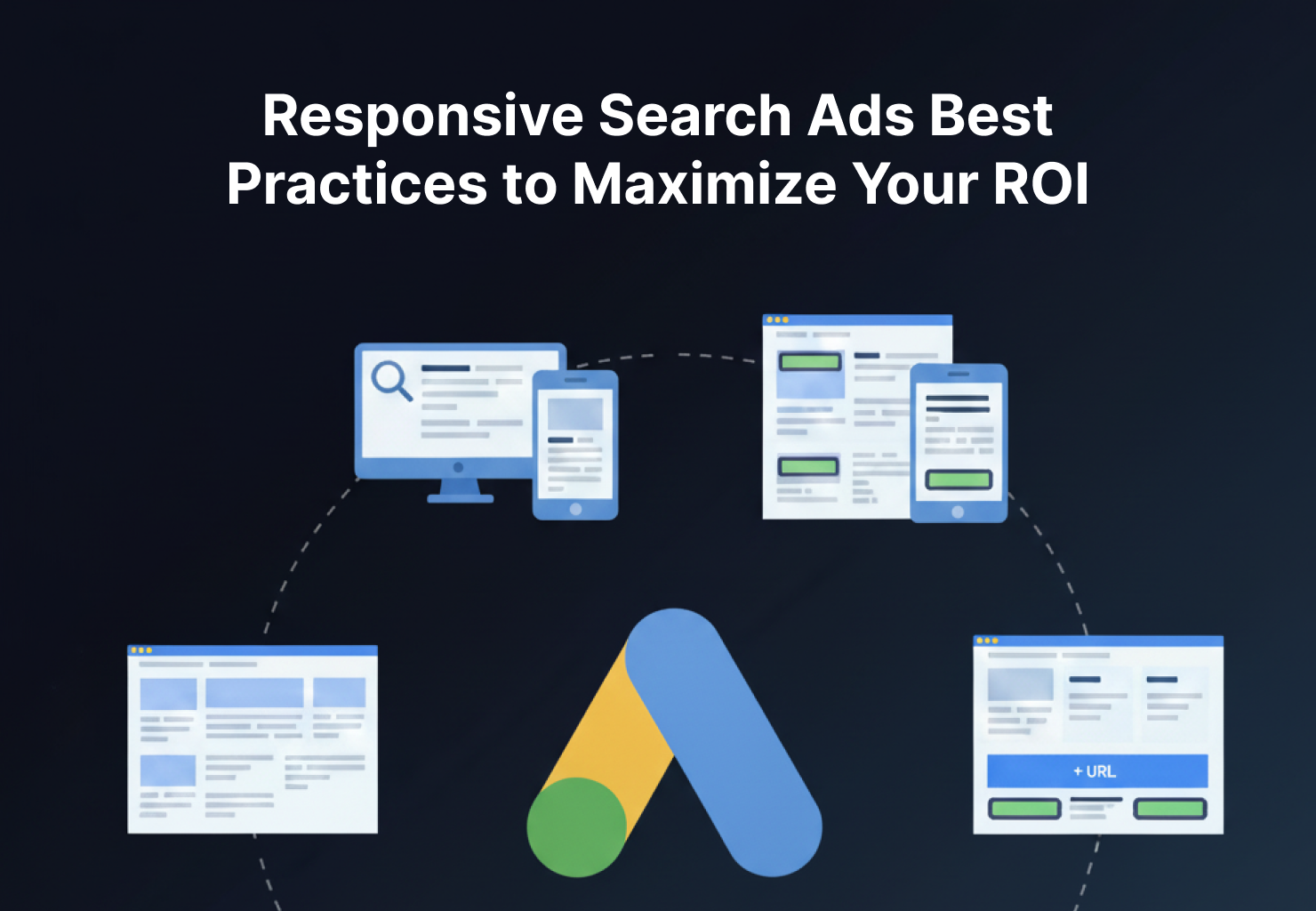Responsive Search Ads (RSAs) are now the default ad format in Google Ads. Instead of writing one static ad, advertisers provide multiple headlines and descriptions, and Google dynamically tests combinations to maximize performance.
But here’s the catch: not all RSAs are created equal. Without the right structure, RSAs can lead to wasted impressions and poor click-through rates. In this guide, we’ll share 12 responsive search ads best practices that will help you write smarter ads, improve Quality Scores, and maximize ROI.
Ready to improve your ad performance today? Talk to our PPC experts for a free consultation.
What Are Responsive Search Ads (RSAs)?
Responsive Search Ads let advertisers provide up to 15 headlines and 4 descriptions. Google automatically mixes and matches them, testing different variations to identify the most effective combination for each search query.
Unlike traditional expanded text ads, RSAs rely heavily on machine learning — but success still depends on the quality of the inputs (your headlines, descriptions, and targeting).
For help setting up high-converting campaigns, check out our PPC Management Services.
Why Responsive Search Ads Matter
- Wider Reach: RSAs qualify for more auctions by matching to more queries.
- Personalization at Scale: Headlines adapt to user intent.
- Improved CTR & Conversions: Well-structured RSAs usually outperform static ads.
- Future-Proofing: Google has sunset Expanded Text Ads, making RSAs the standard.
Struggling to keep up with changes in Google Ads? Request a Free PPC Audit and uncover opportunities to improve your campaigns.
12 Responsive Search Ads Best Practices
- Provide the Maximum Headlines and Descriptions
Use all 15 headlines and 4 descriptions. The more inputs you give Google, the more combinations it can test to find winning ads. - Pin Headlines Strategically
Pin essential elements (like your brand name or main CTA) but avoid pinning too many assets. Over-pinning restricts Google’s ability to optimize.
Not sure how to structure your RSAs? Our team can build them for you. Learn more here. - Use Keywords Naturally in Headlines
Include your primary keyword in at least 3–4 headlines. This boosts ad relevance and helps improve Quality Scores. - Balance Keyword Headlines with Value Propositions
Mix keyword-focused headlines with value-driven ones. For example:
“Cut Your Ad Spend Waste by 30%”
“Certified Google Ads Partner” - Write Headlines with Different Lengths
Use a variety of short and long headlines so Google can adapt ads to different devices and placements. - Leverage Ad Extensions Alongside RSAs
Boost ad visibility by using sitelinks, callouts, price extensions, and structured snippets. Example: link to your Company and Contact Us pages. - Test Multiple CTAs
- Don’t stick to one call-to-action. Test variations like:
- “Get a Free PPC Audit”
- “Request a Proposal”
- “Start Today”
- Use Dynamic Keyword Insertion (DKI) with Caution
DKI can make ads more relevant, but overuse risks awkward or misleading headlines. Limit DKI to high-intent campaigns. - Align Ads with Landing Pages
Make sure your ad promises match the landing page experience. If your headline says “Free PPC Audit,” ensure that offer is front and center on the landing page. - Monitor Asset Performance Ratings
Google labels assets as “Learning,” “Low,” “Good,” or “Best.” Regularly replace low-performing assets and refresh underperforming copy. - Tailor RSAs for Each Campaign or Ad Group
Don’t copy-paste one RSA across all ad groups. Create tailored ads for each intent: branded, competitor, product-specific, or remarketing. - Review Search Term Reports Regularly
RSAs expand reach, which sometimes triggers irrelevant queries. Use negative keywords to filter wasted spend and refine targeting.
Common Mistakes with RSAs (to Avoid)
- Using too few headlines or repeating the same phrases.
- Over-pinning, which limits Google’s machine learning.
- Keyword-stuffing headlines unnaturally.
- Ignoring asset performance ratings.
Don’t waste clicks on poorly structured ads. Schedule a strategy call and let our experts optimize your RSAs.
Frequently Asked Questions about RSAs (Responsive Search Ads)
Q1: What are responsive search ads in Google Ads?
A: RSAs are ad formats that allow you to enter multiple headlines and descriptions. Google then dynamically tests different combinations to find the best-performing ad for each search query.
Q2: How many headlines and descriptions should I add to an RSA?
A: You can add up to 15 headlines and 4 descriptions. Best practice is to use the maximum available to give Google more options for testing.
Q3: Do responsive search ads perform better than expanded text ads?
A: In most cases, yes. RSAs usually drive higher impressions and CTR, but results depend on quality of headlines, pinning strategy, and optimization.
Q4: Should I pin headlines in responsive search ads?
A: Only pin critical headlines (like your brand or offer). Over-pinning restricts Google’s ability to optimize and test variations.
Q5: How many responsive search ads should I run per ad group?
A: Google recommends running one RSA per ad group. Supplement with strong ad extensions for maximum coverage.
Q6: How do I know if my responsive search ads are working?
A: Check metrics like CTR, conversions, and asset performance ratings. Replace or rewrite any “Low” rated assets to improve results.
Conclusion
Responsive Search Ads are one of the most powerful tools in Google Ads — but only if they’re structured strategically. By applying these 12 best practices, you’ll maximize your ad reach, improve CTR, and achieve stronger ROI.
Want to unlock the full potential of RSAs without the trial and error? Get a Free PPC Audit and see how Data Bid Machine can help optimize your campaigns for success.




